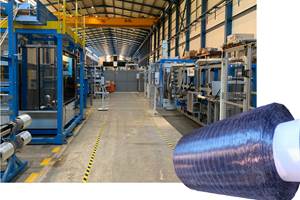Reinforced phenolics: Still disruptive after all these years
Fiber-reinforced phenolics could be a key enabler of a coming automotive industry disruption.
Developed by Belgian-American chemist Leo Baekeland in Yonkers, NY, US, in 1907 and patented in 1909, the filled phenolic resin known as Bakelite was the first commercial composite material. Strong, electrically insulating and resistant to heat, it could be molded into almost limitless shapes. The result was disruptive. It was soon used in place of legacy materials in a broad range of products that included fountain pens, ashtrays, telephones and insulation for electrical wiring. It made a host of products affordable for the masses for the first time. Its use radically altered the established supply chain for these products, and it rapidly put makers of legacy materials (shellac, for example), out of business. Today, the automotive industry is on the brink of a period of significant disruption, and high-performance phenolic composites could be a key enabler in this change.
When I entered this industry in 1988, high-performance composites were considered something of a novelty. The materials had found niche applications and were selected over competitors based on assessments of their performance and price. Fast forward 30 years and the composites industry is a global powerhouse, worth tens of billions of dollars per year and still growing.
The key catalyst for change in the vast majority of markets where composites now find use has been environmental legislation. The low mass of composites compared with competitors, namely metals, is now their unique selling point (USP).
The auto industry is the ultimate case in point. Global regulations on carbon dioxide (CO2) emissions are becoming increasingly punitive. For example, in the Europe Union (EU), the fleet average emissions figure that must be achieved by OEMs in 2021 is 95g of CO2/km. Failure to hit this target will trigger massive fines.
In their quest to satisfy these regulatory requirements, carmakers have sought to reduce vehicle weight. A lighter car can travel farther on a given quantity of fuel, reducing the amount of CO2 released into the atmosphere. As a result, carbon fiber composites — previously the preserve of supercars and fighter jets — have been employed in the structures of mass-production vehicles, such as BMW’s i3, i8 and 7 Series, and Audi’s R8 and A8. Innovative applications for glass fiber composites, used for exterior body panel production since the 1950s, continue to be developed. Under the bonnet, meanwhile, heat-resistant and dimensionally stable phenolic composites have been instrumental in the shift towards smaller, more fuel-efficient — but hotter-running — engines.
Initial results have been impressive. Since 2001 we have seen a continuous decrease in CO2 emissions from vehicles, but in 2015-16 there was a slight increase. This was due in part to the so-called Dieselgate emissions scandal. The public, particularly in Europe, started to buy more gasoline-powered vehicles in response, and there was also an increase in the sales of larger vehicles, such as SUVs. These trends are worrying for carmakers given that fleet average emissions targets in the EU are likely to be reduced further to 75g of CO2/km in 2025.
This is driving a move away from vehicles with conventional internal combustion engines (ICE) to those with plug-in hybrid (PHEV) and fully electric (EV) powertrains. Indeed, in China, the government has set mandatory EV production quotas for OEMs operating there to reduce tailpipe emissions. Many mainstream carmakers have announced ambitious electrification plans, and there could be well over 300 electric and hybrid electric vehicle models launched over the next three years.
This will have a significant impact on the automotive supply chain. A modern ICE powertrain comprises approximately 1,500 parts. Electronic drivetrains have roughly 60 to 70 parts, depending on their complexity. Competition will be fierce amongst suppliers of ICE parts as they attempt to maintain their relevance, and some will find that their current products for such powertrains — exhaust and catalyst systems, for example — are virtually obsolete.
All of this disruption creates opportunities for reinforced phenolics. PHEVs and EVs will need to be as light as they can be. They are heavier than their ICE counterparts; in PHEVs this is due to the dual powertrain, the battery and the converter. In EVs, the battery is very heavy. This added mass requires a stronger chassis and bigger brakes to cope, which adds further weight, not to mention expense. In turn, this reduces the range these vehicles can travel on a single charge.
Phenolic composites are light, but at Vyncolit we are targeting a number of parts in the drivetrains of PHEVs and EVs where the other properties of these materials — such as their corrosion resistance and their knack for enabling functional integration — also can shine.
For instance, a number of automotive suppliers are developing E-axles. PHEVs and EVs currently feature one or two electric motors at the front and one or two at the rear, together with a power converter and a control unit. All of these are separate components. In E-axles, the electric motor, power electronics and transmission are combined in a compact unit (E-motor) that directly powers the vehicle’s axle. Depending on the car’s size, it may require only one E-motor (e.g., the Renault Zoe, on its front axle) or several (e.g., the Tesla S P100, with three E-motors, one on the front axle, two on the rear). This aids in making electric drives less complex, cheaper, more compact and more efficient. Phenolics can be used to overmold light and strong housings for these electric drives, in a cost-effective manner.
Backing plates for brake pads also could benefit from being produced from phenolic composites. These materials are regularly used in disk brake pistons —1.2 billion of which have been manufactured since 1978. Current backing plates are made from steel, to which the friction material is bonded. Sumitomo Bakelite Co. Ltd. has shown that by using phenolic composites rather than steel for these parts, their weight can be reduced by as much as 70% — a significant savings, given that there are eight backing plates on each vehicle. Further, the friction material can be overmolded, so production is simplified, and the bond strength between the pad and the plate can be increased. Further, the inherent vibration-damping properties of the material eliminates the need for shims between the plate and the piston in conventional constructions.
Perhaps most importantly, composite backing plates are inherently corrosion resistant. This is a boon for any vehicle, but will be of particular significance for PHEVs and EVs. In these vehicles, the regenerative braking system plays an important role in deceleration, meaning that the friction brakes are used much less frequently. Indeed, they are equipped with only 5 mm of friction material rather than the conventional 10 mm. When they are fitted with metal backing plates, corrosion renders the PHEV and EV brakes unroadworthy before the friction materials wear through. The use of composites eliminates this problem, optimizing their service life.
Although phenolics have been labeled by some as difficult because they can off-gas moisture during processing at elevated temperature, phenolic molding compounds today can be readily, reliably and efficiently transformed by injection molding, compression molding and transfer molding. The surface quality of molded parts is more than adequate for the applications I’ve described here.
Phenolic and epoxy composites are already being used in induction electric motors for Renault’s electric vehicles and in rotor magnet fixation used in Internal Permanent Magnet E-motors for a carmaker in Asia — these parts have been in serial production for two years. Bakelite may be old technology, but the current balance of cost, processability and in-service performance its phenolic successors can deliver will be key in enabling the new economy.
About the Author
Hendrik De Keyser is chief innovation and technology officer for Vyncolit NV (Ghent, Belgium). A chemical engineer by training, he has logged more than 30 years in the advanced materials and composites sector, and has worked for Vyncolit NV since 1988, beginning as a marketing development manager, responsible for developing applications for phenolics in a variety of industries, and then was responsible for taking these solutions to the North American market. After the company was bought by Sumitomo Bakelite Co. Ltd. (Tokyo, Japan) in 2005, De Keyser returned to Europe to take his current position in January 2016.
Related Content
Novel dry tape for liquid molded composites
MTorres seeks to enable next-gen aircraft and open new markets for composites with low-cost, high-permeability tapes and versatile, high-speed production lines.
Read MoreTU Munich develops cuboidal conformable tanks using carbon fiber composites for increased hydrogen storage
Flat tank enabling standard platform for BEV and FCEV uses thermoplastic and thermoset composites, overwrapped skeleton design in pursuit of 25% more H2 storage.
Read MoreManufacturing the MFFD thermoplastic composite fuselage
Demonstrator’s upper, lower shells and assembly prove materials and new processes for lighter, cheaper and more sustainable high-rate future aircraft.
Read MoreInfinite Composites: Type V tanks for space, hydrogen, automotive and more
After a decade of proving its linerless, weight-saving composite tanks with NASA and more than 30 aerospace companies, this CryoSphere pioneer is scaling for growth in commercial space and sustainable transportation on Earth.
Read MoreRead Next
“Structured air” TPS safeguards composite structures
Powered by an 85% air/15% pure polyimide aerogel, Blueshift’s novel material system protects structures during transient thermal events from -200°C to beyond 2400°C for rockets, battery boxes and more.
Read MorePlant tour: A&P, Cincinnati, OH
A&P has made a name for itself as a braider, but the depth and breadth of its technical aptitude comes into sharp focus with a peek behind usually closed doors.
Read MoreVIDEO: High-rate composites production for aerospace
Westlake Epoxy’s process on display at CAMX 2024 reduces cycle time from hours to just 15 minutes.
Read More






















